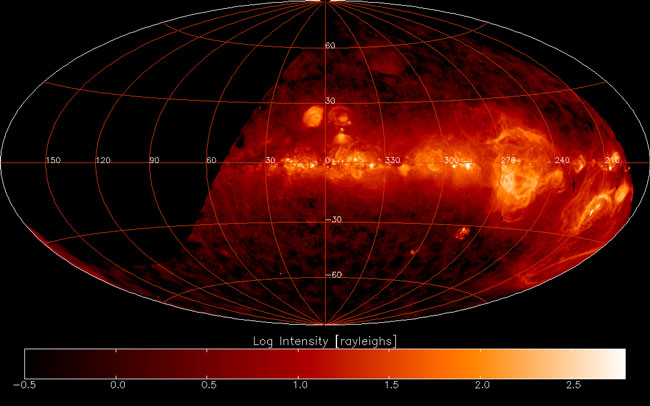Credit & Copyright: SHASSA Team,
NSF
Explanation:
A robotic telescope with red sunglasses in
Chile has been photographing the entire southern sky for years.
The result, shown above, is the most complete sky map of the
most common visible light emitted from the most abundant element in
our Galaxy:
hydrogen.
A very specific red color emitted by warm
ionized hydrogen was observed.
Although spectacular emission nebulas
glow brightly in this type of red light
(H-alpha), a diffuse amount of warm hydrogen is
spread throughout our Galaxy and its glow nicely
indicates not only where
darker hydrogen and other
gasses may be located, but also the sometimes-
complex history of
interstellar gas.
Gas tracking the plane of
our Galaxy
runs across the center, and
huge gas clouds, some of which are the
expanding shells of long
dead stars, are also visible.
The above map was derived from the
Southern H-Alpha Sky Survey Atlas (SHASSA) and shows
that our entire Galaxy is one big
emission nebula,
albeit at a quite faint level.
1999 2000 2001 2002 2003 2004 2005 2006 2007 2008 2009 2010 2011 2012 2013 2014 2015 2016 2017 2018 2019 2020 2021 2022 2023 2024 2025 |
Yanvar' Fevral' Mart Aprel' Mai Iyun' Iyul' Avgust Sentyabr' Oktyabr' Noyabr' Dekabr' |
NASA Web Site Statements, Warnings, and Disclaimers
NASA Official: Jay Norris. Specific rights apply.
A service of: LHEA at NASA / GSFC
& Michigan Tech. U.
|
Publikacii s klyuchevymi slovami:
SHASSA - Milky Way - H-alpha - Mlechnyi Put'
Publikacii so slovami: SHASSA - Milky Way - H-alpha - Mlechnyi Put' | |
Sm. takzhe:
Vse publikacii na tu zhe temu >> | |
